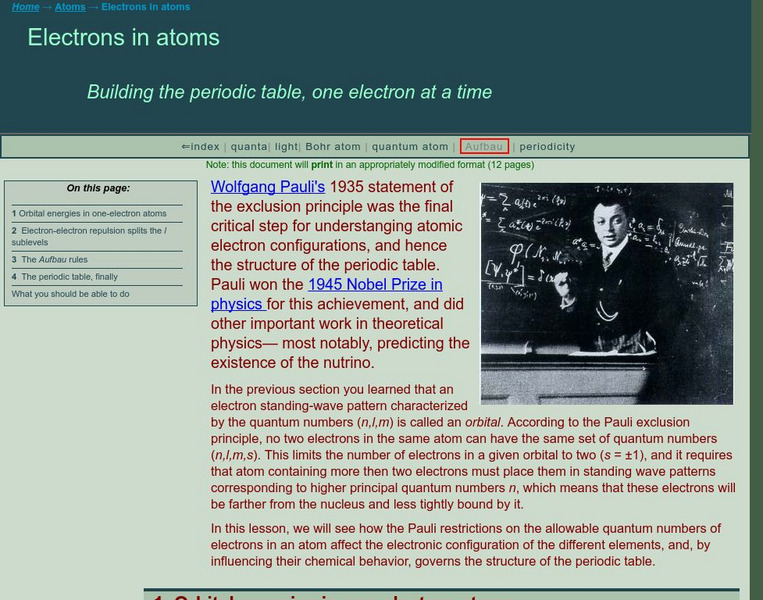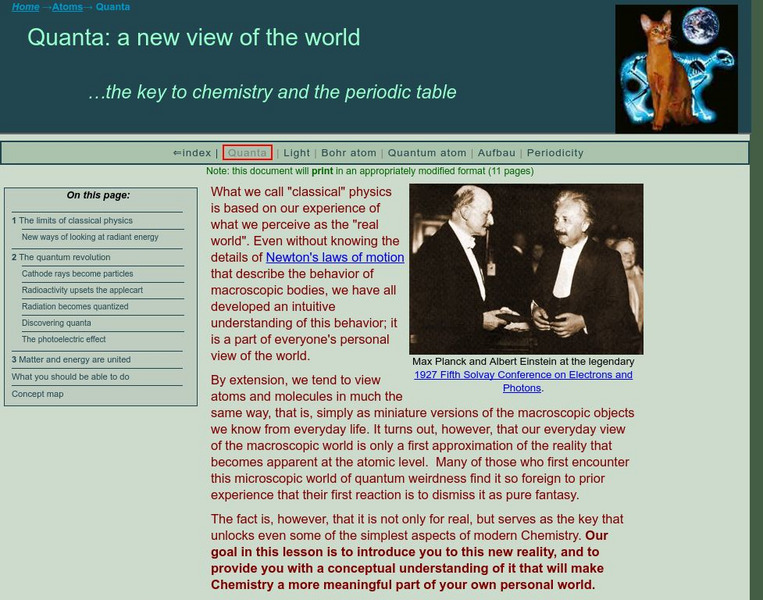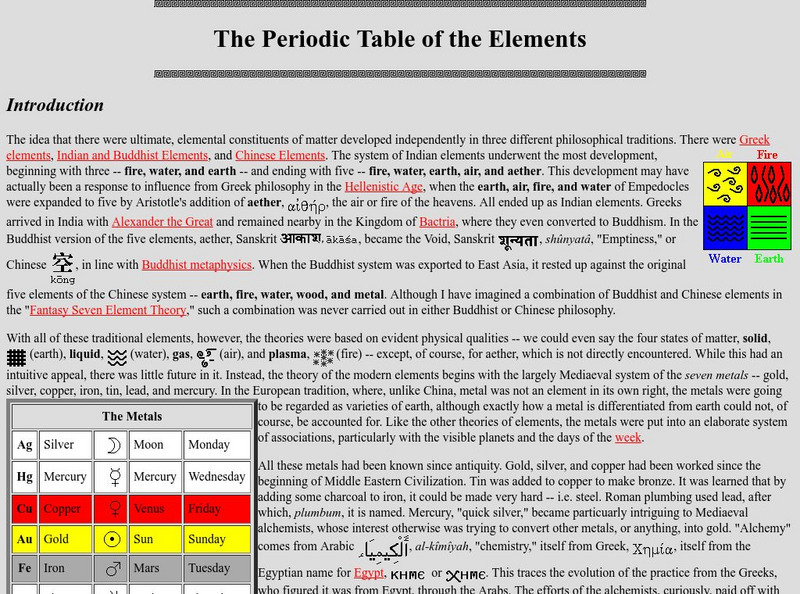Ducksters
Ducksters: Chemistry for Kids: Elements: The Noble Gases
Study the noble gases on this site. Learn about where to find them on the periodic table, what elements are in this group, and other facts.
Ducksters
Ducksters: Chemistry for Kids: Elements: Nonmetals
Kids learn about the nonmetals of the periodic table. Which elements are in this group. Properties, similarities, and other facts are found on this site.
Ducksters
Ducksters: Chemistry for Kids: Elements: Alkali Metals
On this site, investigate the alkali metals of the periodic table. Find out which elements are in this group, properties, similarities, and other facts.
Ducksters
Ducksters: Chemistry for Kids: Elements: Alkaline Earth Metals
Find out about the properties of the elements found in the alkaline earth metals on this site.
Ducksters
Ducksters: Chemistry for Kids: Elements: Lanthanides and Actinides
Kids learn about the lanthanides and actinides of the periodic table. Find out which elements are in this group. properties, similarities, and other facts on this site.
Ducksters
Ducksters: Chemistry for Kids: Elements: Halogens
Explore the halogens of the periodic table. Learn about which elements are in this group and the properties, similarities, and other facts.
Ducksters
Ducksters: Chemistry for Kids: Elements Transition Metals
Kids learn about the transition metals of the periodic table. Which elements are in this group. Properties, similarities, and other facts.
Concord Consortium
Concord Consortium: Stem Resources: Spectroscopy
Web-based activity walks learners through the use of spectroscopy in determining the identity of atoms and molecules by defining the excited state of atoms, the frequencies of emitted photons, and atoms' ability to absorb them....
The Franklin Institute
Franklin Institute: Introduction to Matter
A resource provided to Grade 8 teachers to address the School District of Philadelphia's Core Curriculum on the topic of Matter. It covers properties and states of matter, elements, compounds, mixtures, atoms, and the periodic table....
Department of Defense
Do Dea: Chemistry Review
Review atoms with this slideshow. You can choose to listen to the review or read the accompanying text. At the end, play the game to review the basics of atoms that you have just learned about. You may play the game as many times as...
Concord Consortium
Concord Consortium: Stem Resources: Atomic Structure
Introduces learners to atomic models of the past and present, focusing on the orbital model and an explanation of its basis. Learners then have the opportunity to "make an atom" and contrast it with an ion, followed by an isotope. The...
TeachEngineering
Teach Engineering: Engineering and the Periodic Table
Students learn about the periodic table and how pervasive the elements are in our daily lives. After reviewing the table organization and facts about the first 20 elements, they play an element identification game. They also learn that...
Museum of Science
The Atom's Family: Mighty Molecules
In this activity, students construct models of molecules using marshmallows and gum drops.
Thomas Jefferson National Accelerator Facility
Jefferson Lab: Element Matching Game
Use this resource to practice memorizing the names for the chemical symbols. This interactive resource has a function that will check your answers.
Simon Fraser University
Chem1 Virtual Textbook: The Aufbau Rules
Acting as a subtopic of the General Chemistry Virtual Textbook's section on Atoms and the Periodic Table, this site discusses atomic electron configurations. Specifically, the Aufbau rules are discussed with information on energies of...
Simon Fraser University
Chem1 Virtual Textbook: The Limits of Classical Physics
Acting as a subtopic of the General Chemistry Virtual Textbook's section on Atoms and the Periodic Table, this site discusses the limits associated with classical physics. Topics covered include light and heat with additional information...
Friesian School
Fresian: The Carbon Family C, Si, Ge, Sn, Pb
This resource provides a very technical description of the 5 elements in the Carbon Family.
University of Colorado
University of Colorado: Physics 2000: Elements as Atoms: The Pauli Exclusion Principle
The Pauli Exclusion Principle shows how electrons fill atomic orbitals. Includes biographical information on Wolfgang Pauli.
University of Colorado
University of Colorado: Physics 2000: Elements as Atoms: Electron Clouds and Energy Levels
An explanation of the different types of atomic orbitals, how they are filled according to the Pauli Exclusion Principle, and how many electrons can fit in each electron shell.
University of Colorado
University of Colorado: Physics 2000: Elements as Atoms: Quantum Numbers
Each electron has a set of quantum numbers that specify it's location, orbital, and energy in a unique manner.
Mocomi & Anibrain Digital Technologies
Mocomi: Molecules
When two or more atoms combine they give rise to a molecule. A molecule can be made up of many atoms of the same element. There are 112 elements known to man, so can you imagine the different permutations and combinations of molecules...
TED Talks
Ted: Ted Ed: What Is the Universe Made Of?
The atoms around you have existed for billions of years- and most originated in the flaming, gaseous core of a star. Dennis Wildfogel tells the captivating tale of these atoms' long journeys from the Big Bang to the molecules they form...
Ducksters
Ducksters: Chemistry for Kids: Elements: Mercury
Kids learn about the element mercury and its chemistry including atomic weight, atom, uses, sources, name, and discovery. Plus properties and characteristics of mercury.
Museum of Science
The Atom's Family: Phases of Matter
Help the Phantom choose a material and observe the changes at different temperatures in the molecule chamber. What happens to the elements or molecules as the temperature changes?
Other popular searches
- Science Elements, Atoms
- Elements and Atoms
- Atoms Elements Compounds
- Atoms Elements and Compounds
- Chemical Elements Atoms
- Candy Atoms and Elements
- Science Elements Atoms
- Science Elements and Atoms
- Physics Atoms and Elements
- Atoms Elements Review
- Chemistry Elements Atoms
- Elements Atoms

















